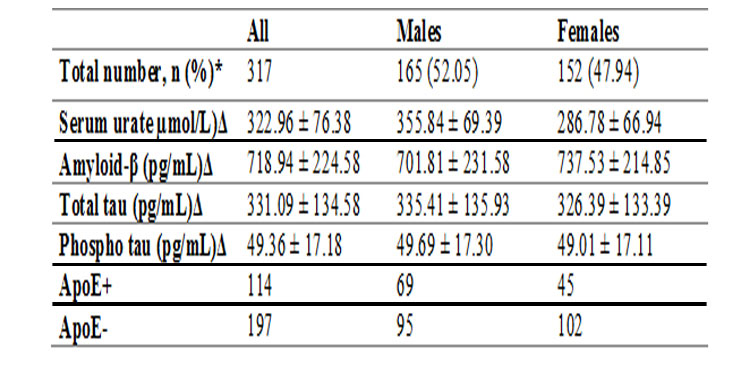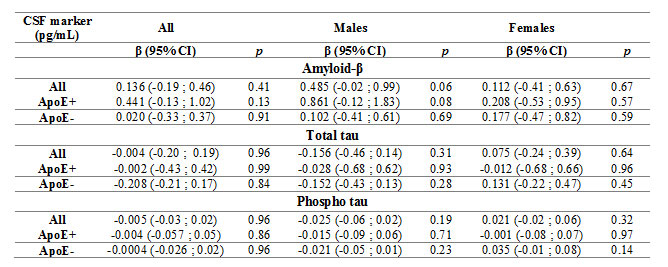Session Information
Date: Monday, November 11, 2019
Title: Metabolic & Crystal Arthropathies Poster II: Clinical Trials & Basic Science
Session Type: Poster Session (Monday)
Session Time: 9:00AM-11:00AM
Background/Purpose: Urate is a powerful antioxidant that accounts for approximately 60% of free-radical scavenging capacity in the human body. The diagnosis of Alzheimer’s dementia (AD) is preceded by years of progressive cognitive impairment. Mild cognitive impairment (MCI) or predementia in AD is characterized by a certain pattern of cerebrospinal fluid (CSF) biomarkers beginning with a decrease of amyloid-β42 (Aβ) in CSF and followed by its aggregation in brain and hyperphosphorylation of the tau protein. The worldwide prevalence of dementia ranges between 5 to 7% with higher incidence of predementia reported in men before the age of 70-75 years. Urate has been suggested to exert potentially neuroprotective effects and might therefore alter the risk of dementia by virtue of its antioxidant abilities. A long-term follow-up study in Swedish women cohort has recently indicated a protective role of serum urate (SU) in the development of dementia. However, the relationship between urate and predementia remains elusive. The study was aimed to investigate the association between SU and predementia using the baseline data from a general population sample of 70-year-olds in Sweden.
Methods: The baseline sample was derived from the population-based H70 Gothenburg Birth Cohort that includes the data of every 70-year-old in Gothenburg, Sweden, born during 1944 (on prespecified birthdates). Overall, this cohort represents the data for 1,203 individuals (46.5% male) collected between 2014 and 2016. For this study, measurements for SU and three CSF markers, Aβ42, total tau and phospho tau, were analyzed from a subset (n=322) of the H70 cohort. The information for the presence of APOE risk allele (for single nucleotide polymorphism/SNPs rs7412 and rs42935) for each individual in this subset was also analyzed. Data for individuals with baseline prevalent dementia (n=5) was excluded from the analysis. Linear regression was performed to assess the association between SU and each CSF marker in overall and gender stratified groups. The groups were further stratified for the presence of APOE risk (ApoE+) or otherwise normal (ApoE-) allele. A p > 0.05 was designated to indicate a significant association. All analyses were performed using statistical software R (v3.5.2).
Results: Overall, 52% of the participants in the analysis were males. Individuals had a mean SU value of 322.9 (males; 355.8 and females; 286.7). A total of 114 individuals were carrying risk allele for APOE, with a higher percentage of males (~60%) being the carriers (Table 1). Regression analysis indicated only a trend of positive association between SU and Aβ in male subset (β = 0.48 pg/mL, p = 0.06), which persisted when assessed in ApoE+ group (β = 0.86 pg/mL, p = 0.08). The positive estimate was also observed in female subset (β = 0.11 pg/mL, p = 0.67), albeit not significant. No association for SU was observed for both total tau (β = -0.004 pg/mL, p = 0.96) and phospho tau (β = -0.005 pg/mL, p = 0.96) (Table 2).
Conclusion: In seventy-year old males we identify a possible protective effect of urate on predementia, defined as decreased CSF levels of amyloid-β and reflecting amyloid build-up in the brain. This effect seems to be further strengthened in the presence of APOE-ε4.
To cite this abstract in AMA style:
Fatima T, Jacobsson L, Johansson L, Dehlin M, Skoog I. The Association Between Urate and CSF Markers of Alzheimer’s Disease in a Population-Based Sample of 70-Year-Olds [abstract]. Arthritis Rheumatol. 2019; 71 (suppl 10). https://acrabstracts.org/abstract/the-association-between-urate-and-csf-markers-of-alzheimers-disease-in-a-population-based-sample-of-70-year-olds/. Accessed .« Back to 2019 ACR/ARP Annual Meeting
ACR Meeting Abstracts - https://acrabstracts.org/abstract/the-association-between-urate-and-csf-markers-of-alzheimers-disease-in-a-population-based-sample-of-70-year-olds/


